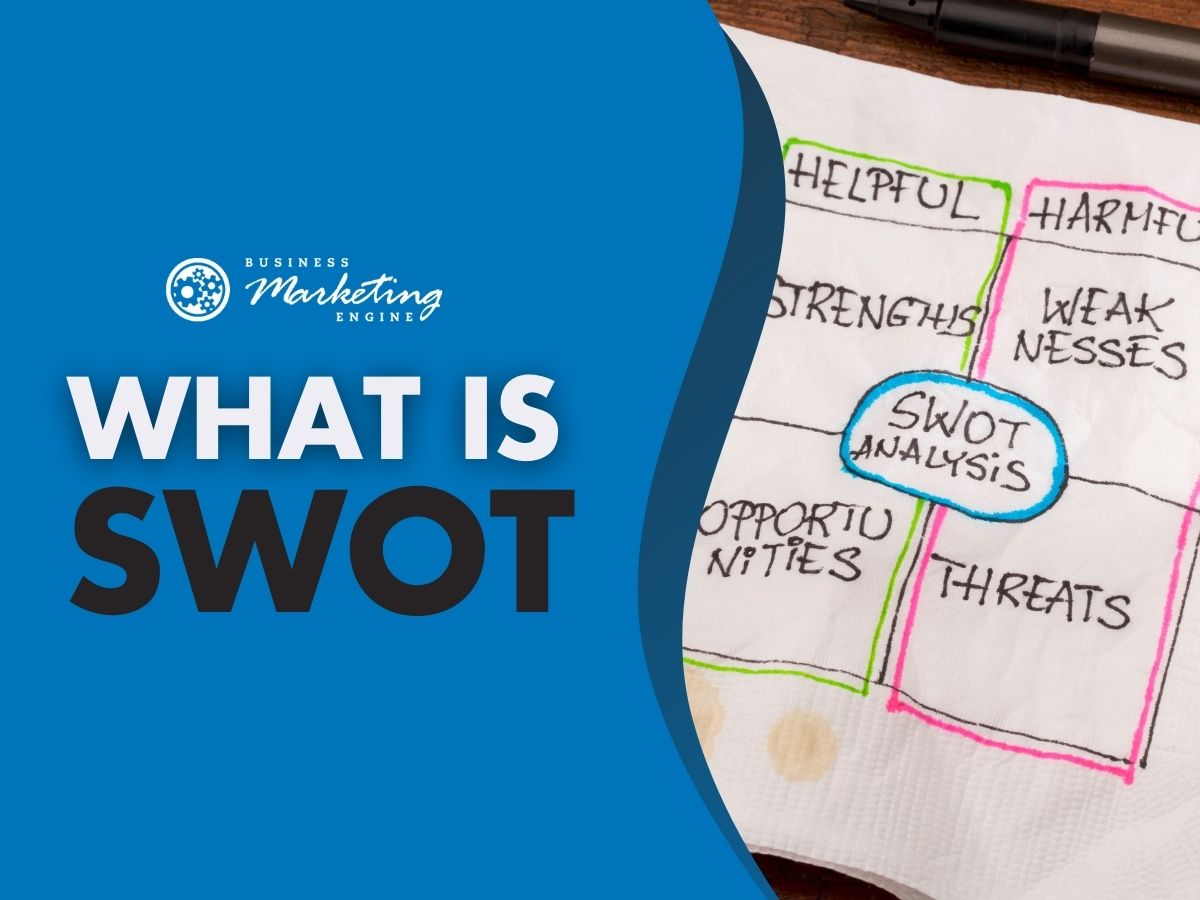Understanding how your business stacks up against the competition help you stay ahead of the curve. Market trends change constantly to adapt to consumer interests. As fads and concerns develop and fade, businesses need to take a good look at where they stand through a SWOT analysis.
When a SWOT analysis uses statistical data and market research properly, it creates valuable insight. A well-executed SWOT analysis potentially saving a business from heading down the wrong path.
What is a SWOT Analysis?
SWOT stands for strengths, weaknesses, opportunities and threats. Strengths and weaknesses refer to the active, internal components of a business. For example, a unique product functions as a strength, giving the business an advantage over competitors. Weaknesses might include an inability to maintain adequate staffing or logistical problems.
Opportunities and threats refer to external factors not yet impacting or experienced by the business. Opportunities include any place where the business can grow, such as a competitor going out of business.
Threats include new competitors, innovation in the industry making a product or service obsolete or a rapidly changing demographic base. When a business performs a SWOT analysis, they take a look at their own business and the broader industry. They can help predict consumer behavior and make market predictions. Regular SWOT analyses help businesses adapt to a changing environment. A change within the industry or society could cause problems for the business if not handled properly.
Why Conduct a SWOT Analysis?
A SWOT analysis helps keep the industry in mind so that a business does not lose sight of its environment. Having a handle on the industry and consumer trends helps a business stay competitive and retain its customer base. A SWOT analysis can help determine a solid strategy for your business going forward.
The majority of a SWOT analysis pertains to the business performing the analysis. Even a business lacking any clear competition should perform a SWOT analysis. When weakness or bottleneck becomes visible, potential competitors see this as an opportunity.
Sometimes, you can spot a major advantage just waiting to be taken advantage of. And when you jump on this advantage, you can win back old customers and attract new ones. SWOT analyses do not only apply to the world of business. Individuals can use a SWOT analysis when they want to improve themselves, as it helps give them direction.
Who Should Conduct a SWOT Analysis?
All active businesses looking to expand or even maintain their business should perform a SWOT analysis. Always assume that your competition wants to expand and put you out of business. This might not necessarily be the case, but keeping it in mind helps you keep it from becoming a reality. It’s also wise to assume that competing businesses will perform SWOT analyses on a regular basis. To stay competitive, you should do the same.
When you leave weaknesses unaddressed or opportunities on the table, you invite competing businesses to take advantage. The sooner you jump on those opportunities or patch those weaknesses, the harder it is for competitors to make hay while the sun shines.
For the results of a SWOT analysis to really have an impact, owners and managers need to take part in the exercise. An outside look can help point out strengths and weaknesses you might not otherwise have noticed. A consultant with expert knowledge and experience in your field will give you the best results from each analysis. You can even poll your customers to get their thoughts on where to improve.
 When Should You Perform a SWOT Analysis?
When Should You Perform a SWOT Analysis?
Entrepreneurs first perform a SWOT analysis when starting a new business. You can only get so far with copying the competition. Instead, a SWOT analysis can help you carve a unique and specific niche in a competitive market environment. Without a preliminary SWOT analysis, a new business will get swallowed up by competitive forces almost immediately.
Active businesses should perform some sort of SWOT analysis, at the very least, on an annual basis. These kinds of general checkups make sure you have a healthy business platform. Weaknesses or threats might be scary, but catching them early might just save your business.
Additionally, before your business launches a new venture or initiative, perform a SWOT analysis centered around your specific change. For instance, if you own an insurance company and want to launch a new coverage option, look at the competition. This way, you are not launching a venture in an already oversaturated market.
And if you find a place for that venture, launch it in a way that makes an impact. This will help you make a splash and attract attention to the initiative, making the investment worthwhile. You might just discover additional opportunities that can help you plan future ventures or expand your current one. So, even if you feel secure in your business, a SWOT analysis might serve as your safety net.
Why is SWOT Analysis Important?
Each SWOT analysis helps you keep the bigger picture in mind. Without a regular SWOT analysis, you put yourself at risk of falling behind in a competitive marketplace. You could also set your new business or initiative up for immediate failure without adequate preparation. Undoubtedly, any business that stays around for a while owes its longevity to a SWOT analysis or two.
Not only will a SWOT analysis keep you in business longer, but it will also save you a lot of money. When your competition gains an edge over your business, it takes a lot of effort to reposition yourself as an industry leader. And effort always means money. Instead of playing catch-up, a well-timed SWOT analysis will help ensure you stay ahead of your competition.
 Characteristics of a SWOT Analysis
Characteristics of a SWOT Analysis
SWOT analyses are divided into two different segments: internal and external factors.
Internal Factors
The internal factors of a SWOT particularly pertain to the strengths and weaknesses sections. When looking at your own strengths and weaknesses, always look within. Internal factors typically include financial and physical resources, current in-house processes and anything else actively available or relevant to your business.
External Factors
No matter the business, some sort of external force will always be present and acting on the market. External factors include the opportunities and threats part of the SWOT analysis. These will occur outside of your business, meaning that they are not something that your business has.
External factors include market and economic trends, funding, demographics, business relationships and legal regulations. Businesses must account for these external factors and do their best to adapt to changing circumstances. For instance, businesses must maintain relationships with suppliers and adhere to any and all legal requirements.
SWOT Analysis Examples
Here are a few examples of SWOT analyses that can be performed on a number of unique businesses.
First up, we have a law firm.
| STRENGTHS | WEAKNESSES |
| This construction law firm has staff members trained to handle cases related to construction and general contracting. Years of experience give them a unique advantage over the competition.
As a small firm with only three employees, they can adapt to changes very quickly. |
None of the staff have mediation experience as a neutral party, nor have they been through any kind of mediation program. |
| OPPORTUNITIES | THREATS |
| A majority of construction projects require mediation of some sort. However, most mediators lack experience specifically related to construction.
Most mediators operate individually. Offering a group-neutral mediation team allows for a better mediation experience for all parties. |
Any other law firm can start offering mediation services.
A lot of clients have a bad impression of what a mediator does, feeling that they will hinder—not help—the process. |
Next, we will examine a sushi restaurant.
| STRENGTHS | WEAKNESSES |
| Sushi restaurant with reasonable prices and no competition within a 10-block radius.
Location is within a business district. The restaurant features exquisite decor and friendly customer service. |
The restaurant lacks an authentic Japanese quality. It also utilizes cheap plastic menus.
Low-quality ingredients. Lacks personality, feels too generic. Location subject to frequent construction work, harming the atmosphere. |
| OPPORTUNITIES | THREATS |
| The restaurant’s city has room for more sushi restaurants, meaning there’s an opportunity for expansion.
Could simultaneously improve menu items and ingredients and also set up a quality review system to maintain satisfaction. Shift to bamboo menus. Offer benefits to retain staff for longer. |
Difficulty retaining and recruiting staff.
Bad reviews due to low-quality ingredients and uninteresting menu items. This problem is made worse by occasional food poisoning reported by customers. |
Here is what a SWOT analysis of a hotel would look like.
| STRENGTHS | WEAKNESSES |
| Family-sized rooms at competitive rates with interesting and exciting decorations.
Very close to a major theme park and the ocean. Shuttle service to a theme park and nearby train station. |
Despite the shuttle, competitors are within walking distance of a theme park.
No luxury suites or luxury amenities; instead, all rooms geared towards families. This leads to a loud environment with yelling kids and crying babies. |
| OPPORTUNITIES | THREATS |
| Increase the number of buses in the shuttle service.
Always improve customer service to help busy families enjoy their vacation. Can also add soundproofing to rooms to keep the noise down. Add playrooms, pools and restaurants to double down on the family aspect. |
Nearby luxury hotels tend to be the preferred destination when they offer lower rates.
The shuttle service does not always run on time, frustrating guests. Entirely dependent on the theme park for business. Poor customer service leads to bad reviews. |
Finally, consider a non-business-oriented SWOT analysis, this one focusing on a student.
| STRENGTHS | WEAKNESSES |
| Creative-minded, geared especially towards art, including painting and drawing and music.
Is fluent in English, French and German Highly organized, capable of focusing on a task for long periods of time without losing focus or becoming distracted. |
Strong aversion to math and science.
Introverted, prefers studying and working alone as opposed to working in a group. This leads to a quiet nature in workgroups and social settings. |
| OPPORTUNITIES | THREATS |
| Look for a creative field geared towards graphic design or music. Could also pursue a teaching career in art or music.
Take advantage of language skills and study abroad. This will result in new experiences and get the student to open up. Organizational skills and strong focus will lead to good grades, opening the opportunity for graduate school. |
Introverted nature may lead to being dismissed by others, leading to a denial of opportunity.
Creative fields often focus on group-oriented projects. Art and music are very competitive fields to get into. |
These four examples can use the results from their respective SWOT analysis to plot a steady course for the future. This will help them survive in a competitive market and make solid decisions regarding their next steps.
Conclusion
Any business, or individual for that matter, can perform a SWOT analysis to try to reach their fullest potential. From a fortune 500 company to someone with fitness goals, the SWOT analysis offers benefits to anyone who uses it.
When performing a SWOT analysis, keep the opinions of expert consultants and current customers in mind. An outside perspective will help keep things true, resulting in a really successful SWOT analysis. And speaking of expert consultants, we at Business Marketing Engine specialize in helping businesses just like yours come up with tried-and-true strategies to drive higher traffic and increase brand awareness. Ready to get started? Give us a call today!


 When Should You Perform a SWOT Analysis?
When Should You Perform a SWOT Analysis? Characteristics of a SWOT Analysis
Characteristics of a SWOT Analysis

